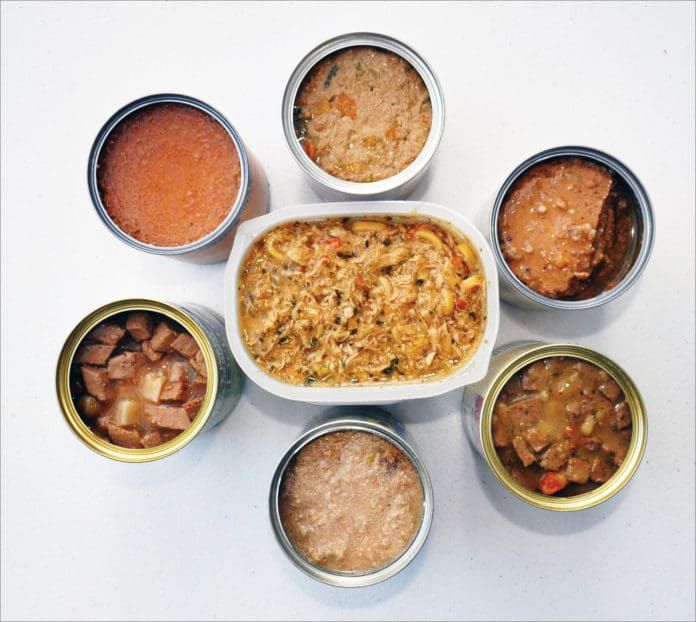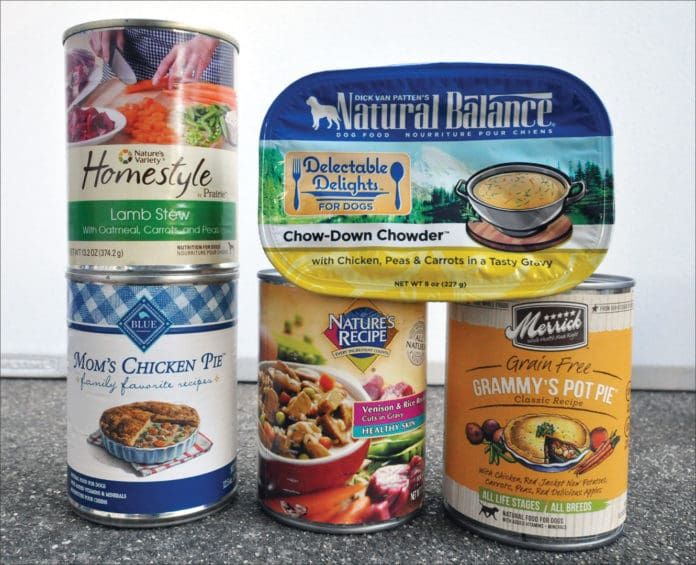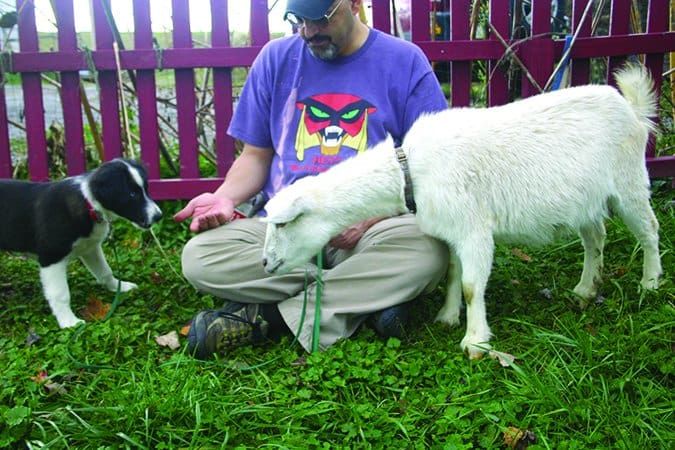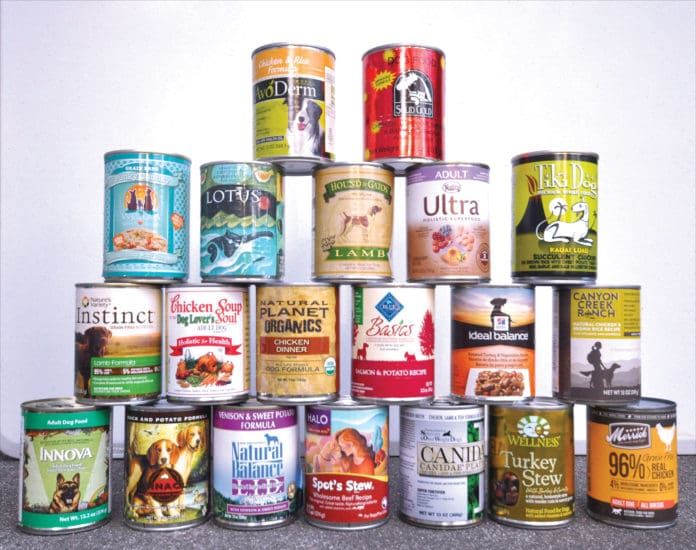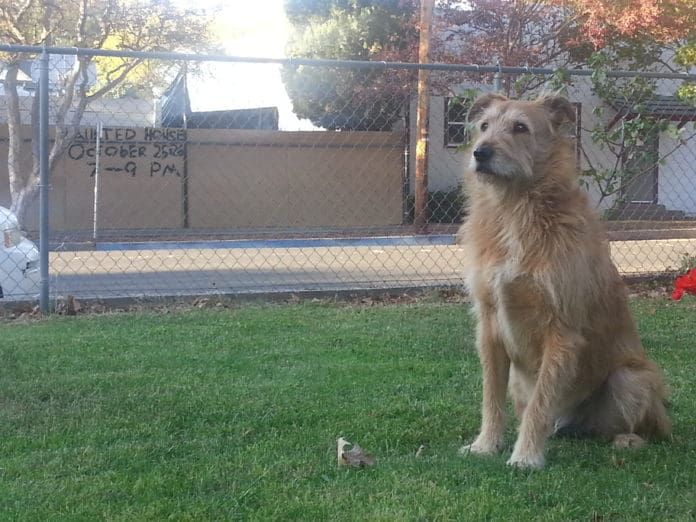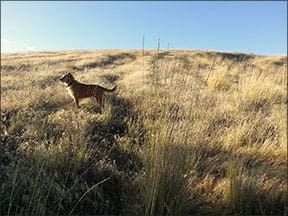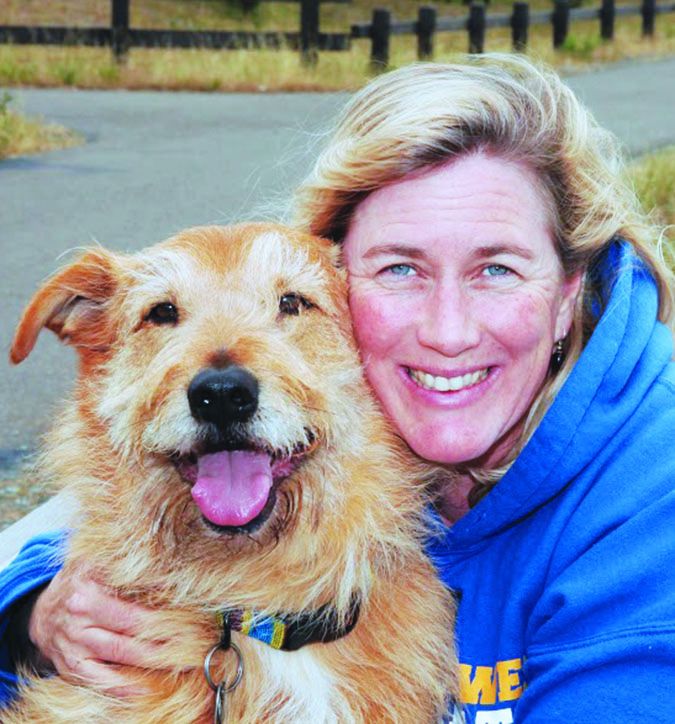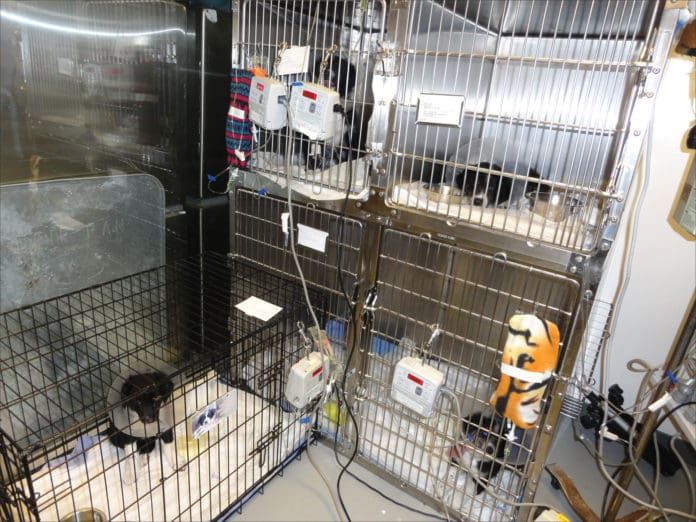Wet dog food, a.k.a. “canned” dog food, is not nearly as popular as dry food. The total sales figure for dry pet food in the U.S. last year (more than $12.7 billion) was more than 21/2 times that of wet pet food (almost $4.8 billion).

I understand the reasons for this, but wish it wasn’t so. Canned food is actually a much healthier diet for dogs than kibble.
Price is the most commonly cited reason that people prefer to feed dry food to their dogs; canned food is far more expensive to feed than dry food. Owners of large dogs or multiple dogs rarely feed canned food as anything other than an occasional treat, for this reason alone.
Of course, there are other objections, too. Many dog owners report that they don’t like the odor of wet food, or the extra work involved in opening the container and serving an appropriate amount – and the hassle of having to store any amount still in the container in a refrigerator for the next meal. And a persistent minority of dog owners worry that dogs who eat only canned food will have more dental problems (such as a buildup of tartar and resulting gum inflammation) than a dog who eats kibble.
These concerns vary in validity.
It’s impossible to counter an objection to the high cost of wet food; it simply is far more expensive to feed canned food than it is to feed kibble. Wet food obviously contains a lot of water, so you have to feed more of it (in terms of weight and volume) than dry food to deliver the nutrients your dog requires. Because it’s so heavy, it’s far more expensive for the pet food companies and distributors to ship wet food than dry food, too.
That said, the cost of feeding top-quality canned food is comparable to the cost of feeding commercial raw frozen or dehydrated diets – and lots of people find a way to pay for those foods.
I’m not sure I could sympathize very deeply with someone who didn’t want to feed wet food to a dog who would clearly benefit from that type of diet due to the off-putting aroma of the food, or the inconvenience of opening cans or storing opened-but-not-emptied pouches. Maybe if the owner was pregnant or chronically nauseated, and there was no one else to take over the dog-feeding job?
The dental objection, though: That one is bogus. I know that at least one of the dog food companies have conducted studies demonstrating that dogs who eat special “dental health” kibble end up with less tartar on their teeth than dogs fed another diet. But it’s pretty widely recognized that few (if any) dogs chew kibble well enough to scrape anything off their teeth – and especially off the exterior sides (cheek sides) of their teeth, where tartar is most likely to accumulate. If anything, crunching kibble can lodge pieces of the carbohydrate-laden food between the dog’s teeth, where those carbs get broken down into sugars and contribute to the development of dental plaque.
Wet food lacks any sort of abrasive material, but the better products also contain far fewer (if any) carbohydrates, the main contributor in a dog’s diet to the accumulation of dental plaque. Ideally, dogs chew and scrape their teeth clean by being given regular opportunities to chew appropriately sized fresh, raw bones in a supervised setting.

Let’s Talk Pros
Enough about why people might not feed canned food to their dogs; here are a lot of reasons why they should.
Meat
Animal protein is a staple – the most important ingredient – in the evolutionary diet of dogs. It may make up as much as 95 percent of what’s in a “complete and balanced” canned food. Even lower-quality canned foods that contain several grains or other carb sources generally contain more animal protein than some high-quality dry foods, because there is a mechanical limit to the amount of animal tissue that can be incorporated into kibble in the manufacturing process. That limit has increased significantly in the past decade or two, as technological innovations (and a demand for grain-free dry foods) have enabled pet food companies to push past former manufacturing limits. But high-protein, high-fat dry foods are highly vulnerable to oxidation. In contrast, canning is a near-perfect preservation system for foods with a high meat inclusion.
The high moisture content is one compelling reason to feed canned food. On average, wet dog foods contain about 78 percent moisture, though the lower-quality products that contain grain may have as little as 65 percent and some of the soupier varieties may contain as much as 85 percent or more. A high-moisture diet is especially helpful for dogs who are prone to urinary tract infections – or, in fact, for dogs with any sort of urinary tract or kidney disorder.
Palatability
Most dogs love canned food. The high meat (and moisture) content and the fresh (not rancid) aroma probably accounts for this. Even very old and sick dogs who have lost their appetites can usually be tempted into eating canned food.
Safety
The canning process kills any pathogenic bacteria that may have been in the food. Of course, as we learned during the massive pet food recalls in 2007, bacteria isn’t the only potentially harmful thing that can be in pet food; if an ingredient is adulterated with something toxic (such as melamine, an industrial chemical), canning won’t render the ingredient safe.
Far fewer additives
The canning process itself preserves the food, so preservatives are not needed or used. Artificial colors are used only rarely in canned food (and generally only in the lowest-quality products).
Digestibility
Most dogs digest canned food well, with a reduced volume of stool, and often, a lower production of intestinal gas.
Quite Variable
All things considered, good canned foods have a lot to offer our dogs. But the products offered by the pet food industry as a whole aren’t at all equal; there is much more variety in this category of dog food than in dry food.
For example, as previously mentioned, the moisture content in canned foods varies quite a bit, from as little as 65 percent to as much as 85 percent.
That range will be reflected in the appearance of the food. Some canned foods look like soup or stew, with chunks of meat (or shredded meat) and other ingredients suspended in a gravy; these obviously contain the highest amount of moisture. The lowest-moisture canned foods are generally referred to as “loaf” type products; these are the products with a more or less uniform consistency (if you opened both ends of the can and dumped out the contents, you’d have a perfect can-shaped loaf of food).
A canned dog food may contain no carbohydrates whatsoever, consisting of just animal protein and some vitamins and minerals to “complete and balance” the diet. (Remember, dogs have no biological requirement for carbohydrates; all of their nutritional needs can be met with protein and fat sources.) At the other end of the spectrum, a canned food may contain lots of grain or other carbohydrate sources.
Another huge variable in this type of food is the amount of fat present. Products that contain a lot of carbs are likely to contain less fat than the carb-free foods, but most canned foods contain more fat than the average dry food. You may have difficulty finding the perfect canned food if your dog tends to gain weight easily, has trouble digesting fatty foods, or is prone to pancreatitis (or is one of the breeds that is prone to pancreatitis).
Keep in mind that fat contains more than twice the amount of calories per gram than protein or carbohydrate. (Fats contain 9 calories per gram; proteins and carbohydrates contain 4 calories per gram). High-fat foods, then, are also high-calorie foods. This is ideal for highly active dogs or canine cancer patients suffering from cancer cachexia (a condition that alters the dog’s metabolism, causing the loss of body fat and muscle mass). Normal dogs, however, may experience alarmingly fast weight gain if switched to a high-fat food without a reduction in the amount of food given.
Hallmarks of Quality
The “macro” traits discussed above – the amounts of moisture, carbs, and fat – are factors to keep in mind when choosing a food for your dog (and budget). But none of those factors qualify a product as a “good” or “bad” food. In our opinion, the quality of a food is revealed in its ingredients.
And since the main advantage of canning is its ability to deliver a much higher percentage of animal protein than kibble is able to, in a much more shelf-stable and bacteria-free form, the first and foremost indicator of a canned dog food’s quality, in our opinion, is the amount and type of meat included in the formula.
Water (or broth) as required for processing is often among the first few ingredients listed on a canned food label, but a whole, named animal protein (or two) ought to be right next to it.
“Whole” means no by-products – although you should be aware that it doesn’t mean only the muscle tissue you might ordinarily associate with chicken breasts and beef steaks; the official definition of each type of meat includes fat and “the portions of skin, sinew, nerve, and blood vessels which normally accompany the flesh.” The legal definition of poultry (chicken, duck, and turkey) includes flesh and skin, with or without accompanying bone.
“Meat by-products” include lungs, spleen, kidneys, brain, livers, blood, bone, fat, and stomachs and intestines that have been “freed of their contents.” Poultry by-products include heads, feet, viscera (“free from fecal content and foreign matter except in such trace amounts as might occur unavoidably in good factory practice”). We do not consider foods that contain animal by-products for our “approved food” lists.
“Named” means a specific animal species – chicken, beef, pork, lamb – as opposed to “meat,” which can be just about anything.
Because we are looking for products with the highest possible inclusion of top-quality animal proteins, we’d choose a product with meat first on the label over one that listed water first and meat second.
If vegetables, grains, or other carb sources are used, we prefer to see them in their whole forms, rather than by-products (potatoes, rather than potato starch, for example).
The use of grains and other starches should be limited in a canned food; there is little sense in paying canned food prices for carbs. Otherwise, just add meat and water to a dry food! So a food that contained just one grain or vegetable by-product (such as oat bran) would be preferable to a product containing several (such as potato starch, oat fiber, and tomato pomace).
Traits of Lower-Quality Foods
There are a number of traits that automatically disqualify a canned food from our consideration. The first and most important is the inclusion of an unnamed animal source, such as:
– “Meat” or “meat by-products”
– “Poultry” or “poultry by-products”
– “Animal fat”
Wheat gluten is the next disqualifier. Wet foods often contain some sort of thickener or binder. Various types of “gum” (such as guar gum, from the seed of the guar plant, and carrageenan gum, from seaweed) are common thickeners. Whole grains, potatoes, and sweet potatoes also can be used to thicken wet food. But wheat gluten (and some other glutens) are generally used in wet foods both to augment the protein content of the food (albeit with lesser quality amino acids) and to act as a binder, to hold together artificially formed “chunks” so that they resemble chunks of meat. In other words, it’s a cheap replacement for a greater amount of animal protein. If chunks of meat are present in a wet dog food, they should be actual chunks of meat.
Sugar, molasses, or other sweetener used in a canned food is another automatic strikeout. A food that contains quality meats shouldn’t need additional palatants to entice a dog’s appetite.
Finally, as ever, we disqualify foods that contain artificial colors, flavors, or preservatives. These are rare in wet foods, but do appear from time to time.
The Right Price
The cost of canned food will undoubtedly factor into your purchasing decision. In general, the more meat that’s present in a canned food, the higher the price; also, higher-quality ingredients (such as organic or grass-fed meat sources) will increase the price of the food. In fact, some of these foods are crazily expensive; but some of you are willing and able to spend any amount for a suitable, top-quality food for your dog.
The local availability of these foods varies quite a bit and can also affect your buying options. Some are national brands that can be found in chain pet specialty stores (such as Petco and Petsmart); others are distributed only through independent pet specialty stores and perhaps natural food stores. Many can be purchased online, but shipping of canned food adds even more to an already high relative cost.
How To Choose
Many readers would appreciate it if we would present a rank-ordered list of recommended foods. But this is an impossible task, since it would have to be customized for each individual dog, owner’s budget, and local availability. Plus, what’s “best” for my super-active, large-breed dog is not what’s “best” for your couch-potato Pug who is allergic to chicken.
No, only you can identify appropriate prospects for your individual dog, keeping in mind the macro factors discussed above (the amount of moisture, carbs, and fat that you think will best suit your dog.
What we will do, however, is supply you with a list of potential candidates, companies that make canned foods that meet our basic requirements, and do not contain any disqualifying attributes. This “approved foods” list (found at the bottom of each page of this article) is a good place to start looking for foods that might be “best” for your dog.
Please note that the products are NOT rated or ranked; they are listed alphabetically by company.
It’s best to know what sort of attributes you are looking for before you walk into the pet supply store. For example, if your dog is overweight, you should be searching for a relatively lower-fat food with a higher protein content than the one you currently feed. Though pet food makers are not required to list the caloric content of their foods, many of them report this information voluntarily, and this can help you determine whether you might need to feed more or less of a particular food.
Some other selection tips:
– If your dog is itchy (the number one symptom of allergy in dogs), look for a limited ingredient food (a single protein and a single carb source, preferably not a grain) that contains none of the ingredients that his current food contains.
– If your dog is too thin, or acts hungry all the time, look for a food with a higher fat content, particularly if the food you’re feeding now is low in fat.
– If your dog seems to be losing condition as she ages, look for a food with more protein and higher-quality protein sources than the one she’s eating (i.e., chicken, rather than chicken by-products or “meat”).
– If your dog is a picky eater, try rotating foods more often, and offer foods with different protein sources to see which are most appealing.
Adjust as Necessary
You may have been told that it’s bad to switch foods, or you may have had a bad experience when your dog ate something different and unauthorized (by you) and erupted in gas or diarrhea. Don’t be afraid to change foods frequently! It’s true that when a dog is fed the same diet for weeks and months on end, the amount and varieties of digestive enzymes and bacteria in their digestive tracts decrease. But the more frequently you change their diets, the more robust and capable their digestion becomes. You can also help your dog adjust more quickly to variety in his diet by giving him digestive enzyme, probiotic, and prebiotic supplements, to help his gut recolonize itself with digestion-aiding agents.
Then, watch your dog! Let him tell you how the new food works for him. Keep track of what foods you’ve tried and what has and has not worked on a calendar dedicated to this purpose or in a diet journal, so you can continue to make adjustments and, we hope, improvements in your dog’s diet.


